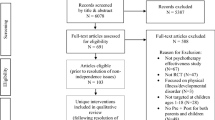Abstract
The goal of this brief report is to demonstrate the utility of quantifying parental discipline practices as relative frequencies in measuring changes in parenting behavior and relations to child behavior following intervention. We explored comparisons across methodological approaches of assessing parenting behavior via absolute and relative frequencies in measuring improvements in parent-reported disciplinary practices (increases in positive parenting practices in response to child behavior; decreases in inconsistent discipline and use of corporal punishment) and child behavior problems. The current study was conducted as part of a larger clinical trial to evaluate the efficacy of a collaborative care intervention for behavior problems, ADHD, and anxiety in pediatric primary care practices (Doctor Office Collaborative Care; DOCC). Participants were 321 parent-child dyads (M child age = 8.00, 65 % male children) from eight pediatric practices that were cluster randomized to DOCC or enhanced usual care (EUC). Parents reported on their own discipline behaviors and child behavior problems. While treatment-related decreases in negative parenting were found using both the absolute and relative frequencies of parenting behaviors, results were different for positive parenting behaviors, which showed decreases when measured as absolute frequencies but increases when measured as relative frequencies. In addition, positive parenting was negatively correlated with child behavior problems when using relative frequencies, but not absolute frequencies, and relative frequencies of positive parenting mediated relations between treatment condition and outcomes. Our findings indicate that the methods used to measure treatment-related change warrant careful consideration.

Similar content being viewed by others
References
Carr, E. G., Taylor, J. C., & Robinson, S. (1991). The effects of severe behavior problems in children on the teaching behavior of adults. Journal of Applied Behavior Analysis, 24, 523–535.
Chamberlain, P., Price, J., Leve, L. D., Laurent, H., Landsverk, J. A., & Reid, J. B. (2008). Prevention of behavior problems for children in foster care: Outcomes and mediation effects. Prevention Science, 9, 17–27.
Chen, K., Cheng, Y., Berkout, O., Lindhiem, O. (2016). Analyzing proportion scores as outcomes for prevention trials: A statistical primer. Prevention Science. doi:10.1007/s11121-016-0643-6.
Eyberg, S. M., Nelson, M. M., & Boggs, S. R. (2008). Evidence-based psychosocial treatments for children and adolescents with disruptive behavior. Journal of Clinical Child and Adolescent Psychology, 37, 215–237.
Hayes, A. F. (2013). Introduction to mediation, moderation, and conditional process analysis. New York: Guilford Press.
Kaminski, J. W., Valle, L. A., Filene, J. H., & Boyle, C. L. (2008). A meta-analytic review of components associated with parent training program effectiveness. Journal of Abnormal Child Psychology, 36, 567–589.
Kieling, C., Baker-Henningham, H., Belfer, M., Conti, G., Ertem, I., Omigbodun, O., Rohde, L. A., Smith, S., Ulkuer, N., & Rahman, A. (2011). Child and adolescent mental health worldwide: Evidence for action. The Lancet, 378, 1515–1525.
Kolko, D. J. (2006). Doctor-office collaborative care management: Clinician treatment manual. Unpublished manuscript, Services for Kids In Primary-care (SKIP), Department of Psychiatry, University of Pittsburgh School of Medicine, Pittsburgh, PA.
Kolko, D. J., Campo, J., Kilbourne, A. M., Hart, J., Sakolsky, D., & Wisniewski, S. (2014). Collaborative care outcomes for pediatric behavioral health problems: A cluster randomized trial. Pediatrics, 133, e981–e992.
Lindhiem, O., Shaffer, A., & Kolko, D. J. (2014). Quantifying discipline practices using absolute versus relative frequencies: clinical and research implications for child welfare. Journal of Interpersonal Violence, 29, 66–81.
Raudenbush, S. W., & Bryk, A. S. (2002). Hierarchical linear models: Applications and data analysis methods (2nd ed.). Thousand Oaks, CA: Sage.
Schuhmann, E. M., Foote, R. C., Eyberg, S. M., Boggs, S. R., & Algina, J. (1998). Efficacy of parent-child interaction therapy: interim report of a randomized trial with short-term maintenance. Journal of Clinical Child Psychology, 27, 34–45.
Shelton, K. K., Frick, P. J., & Wootton, J. M. (1996). Assessment of parenting practices in families of elementary school-age children. Journal of Clinical Child Psychology, 25, 317–329.
Simons, R. L., Wu, C. I., Lin, K. H., Gordon, L., & Conger, R. D. (2000). A cross‐cultural examination of the link between corporal punishment and adolescent antisocial behavior. Criminology, 38, 47–80.
Snyder, J. J., & Patterson, G. R. (1995). Individual differences in social aggression: a test of a reinforcement model of socialization in the natural environment. Behavior Therapy, 26, 371–391.
Wolraich, M. L., Hannah, J. N., Baumgaertel, A., & Feurer, I. D. (1998). Examination of DSM IV criteria for attention deficit/hyperactivity disorder in a county-wide sample. Journal of Developmental & Behavioral Pediatrics, 19, 162–168.
Wolraich, M. L., Lambert, W., Doffing, M. A., Bickman, L., Simmons, T., & Worley, K. (2003). Psychometric properties of the Vanderbilt ADHD diagnostic parent rating scale in a referred population. Journal of Pediatric Psychology, 28, 559–568.
Author information
Authors and Affiliations
Corresponding author
Ethics declarations
Funding
This research was supported by grants from the National Institute of Mental Health (MH093508; MH062272).
Conflict of Interest
The authors declare no conflict of interest.
Ethical Approval
All data collection procedures were carried out with approval from, and in compliance with, the IRB at the University of Pittsburgh.
Informed Consent
Informed consent was obtained from all individual study participants.
Additional information
Author Note
This research was supported by grants from the National Institute of Mental Health (NIMH) to the second author for the preparation of this article (MH093508) and to the third author for the research data collected in this study (MH062272). The authors would also like to thank Charles Bennett for his assistance with formatting and editing of the manuscript.
Rights and permissions
About this article
Cite this article
Shaffer, A., Lindhiem, O. & Kolko, D. Treatment Effects of a Primary Care Intervention on Parenting Behaviors: Sometimes It’s Relative. Prev Sci 18, 305–311 (2017). https://doi.org/10.1007/s11121-016-0689-5
Published:
Issue Date:
DOI: https://doi.org/10.1007/s11121-016-0689-5




